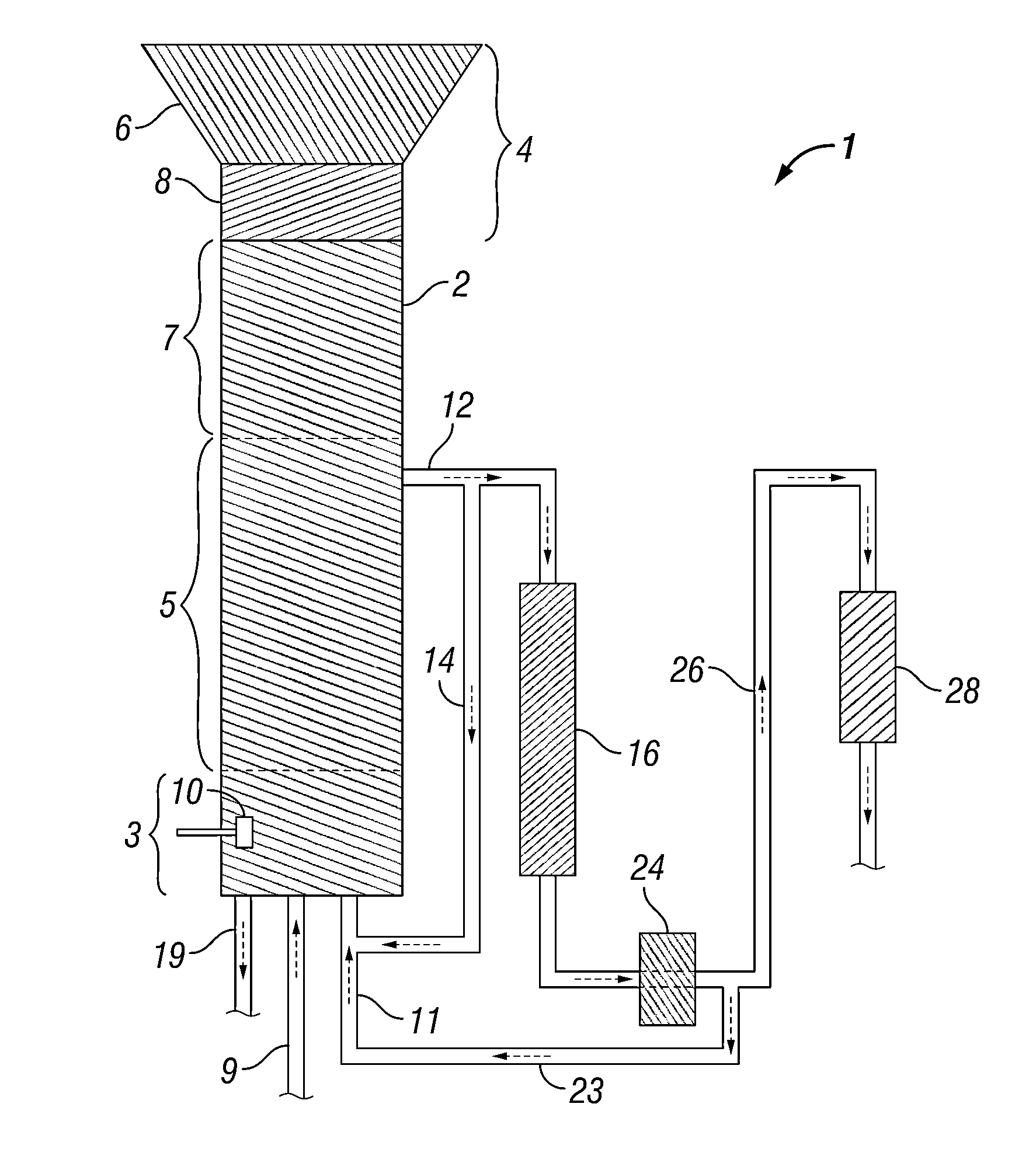Methods and systems for processing lignin during hydrothermal digestion of cellulosic biomass solids
a technology of hydrothermal digestion and cellulosic biomass, which is applied in the direction of chemical/physical/physicochemical processes, other chemical processes, papermaking, etc., can solve the problems of slow development and implementation of bio-based fuel technology, difficult processing of lignin, and difficult to deal with lignin in particular, so as to and reduce the viscosity of phenolics
- Summary
- Abstract
- Description
- Claims
- Application Information
AI Technical Summary
Benefits of technology
Problems solved by technology
Method used
Image
Examples
example 1
Formation and Separation of a Phenolics Liquid Phase
[0135]A 75 mL Parr5000 reactor was charged with 20.2 grams of 25% 2-propanol solvent in deionized water, 0.12 grams of sodium carbonate buffer, and 0.302 grams of grams of sulfided nickel oxide promoted cobalt molybdate catalyst (DC-2534, Criterion Catalyst & Technologies L.P., containing 1-10% cobalt oxide and molybdenum trioxide (up to 30 wt %) on alumina, and less than 2% nickel). The catalyst was previously sulfided as described in United States Patent Application Publication 2010 / 0236988, which is incorporated herein by reference in its entirety. The reactor was then charged with 4.98 grams of southern pine mini-chips (39% moisture, nominal dimensions of 3 mm×5 mm×5 mm), before pressurizing with 52 bar of hydrogen. The stirred reactor was heated to 190° C. for 1 hour, followed by heating to 240° C. for 4 hours to complete a 5 hour cycle. At the end of the cycle, the reactor was cooled and allowed to gravity settle overnight. 4...
example 2
Viscosity and Flow Behavior of the Phenolics Liquid Phase
[0138]1.002 grams of the lower phase from Example 1 was placed in a vial on a block heater and heated to 110° C. for 30 minutes to observe flow behavior. No flow of the lower phase was observed using a falling film viscosity assessment method, either at room temperature or at 110° C., leading to an estimated viscosity of greater than 10,000 cP. Basis for the estimated viscosity was flow behavior observed in an analogous test with ambient temperature molasses.
[0139]Samples of the lower phase were diluted 1:10 into 50% ethanol and heated to 80° C., upon which a flowable, non-miscible lower phase was observed with an estimated viscosity of 1000 cP, as determined via falling film viscosity measurement of a standard material (glycerol). A flowable but immiscible lower phase was also obtained by mixing 1 part of the lower phase with 10 parts of 45% propylene glycol / 5% ethylene glycol in deionized water. The lower phase was completel...
example 3
High Temperature Reversion of the Phenolics Liquid Phase
[0140]0.306 grams of the lower phase produced in Example 1 were mixed with 0.101 grams of the sulfided catalyst and 0.05 grams of potassium carbonate buffer in a 5 mL heavy wall reaction vial with V-shaped bottom. The vial was carefully heated for 5 hours at 290° C. in a Parr5000 reactor packed with sand for thermal heat transfer under an initial pressure of 25 bar of hydrogen.
[0141]Following thermal treatment of the lower phase, it became flowable at 110° C. with no solvent addition required. The viscosity was estimated as greater than 1000 cP. A sample dissolved 1:10 in n-octanol for GC analysis again indicated no detectable peaks having a volatility less than sorbitol. Subsequent analysis of the hydrotreated lower phase indicated the presence of low concentrations of substituted phenols, including propyl phenols.
PUM
| Property | Measurement | Unit |
|---|---|---|
| temperature | aaaaa | aaaaa |
| temperature | aaaaa | aaaaa |
| temperatures | aaaaa | aaaaa |
Abstract
Description
Claims
Application Information
 Login to View More
Login to View More - R&D
- Intellectual Property
- Life Sciences
- Materials
- Tech Scout
- Unparalleled Data Quality
- Higher Quality Content
- 60% Fewer Hallucinations
Browse by: Latest US Patents, China's latest patents, Technical Efficacy Thesaurus, Application Domain, Technology Topic, Popular Technical Reports.
© 2025 PatSnap. All rights reserved.Legal|Privacy policy|Modern Slavery Act Transparency Statement|Sitemap|About US| Contact US: help@patsnap.com



